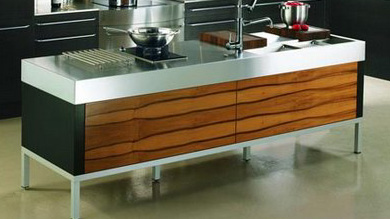Question
Are there any guidelines on "properly sealing" a post-form top at the seam and what sealant to use?
The installer put DAP in the seam (fair amount) and two months later the seam was buckling. The sink is only located 8" away from it in the front. Can a properly-sealed seam buckle from constant moisture (kitchen towel placed on top of if to drain dishes) or what other factors could have caused it?
If the seam is sealed properly is it fair to say that it still may let moisture in that will cause damage to the substrate? If so I will need to enter a new clause in my warranty.
Forum Responses
(Laminate and Solid Surfacing Forum)
From contributor H:
If the seam is 8" away in front where is it in the back? Isn't it a butt joint or is it a mitre? Damp dish towels or any constant moisture will eventually get in regardless if sealant. Is a dishwasher under the joint?
Over tightening connection bolts will cause joint problems. The substrate crushes over time and has to go somewhere either bulging the top or blowing out the bottom. We keep joints of any kind as far from sinks and dishwashers as possible.
Who's at fault? Everyone from the designer to the seller, mfg., installer and consumer. The solution is to make a new top. Pre-form the top again and hope for the best or different style top where the joint is not accessible to water. If it were up to me I would sell everyone on a square lip top. Who is going to step up and bite the bullet and assume the new cost of the top?
Can anyone please tell me if the miter seam of a pre-formed top that is perfectly sealed with proper sealant can buckle from water if it is applied constantly over three 3 months? So far it sounds like no one is really sure. Thanks again for all your knowledge and help.
If you make your own tops I'd talk them out of a replacement top in post-form. Assuming the return legs are under 60in you could offer them something without a seam.
However, the TYPE III Adhesives are a good item to use at that seam. They are a one-part polyurethane and they offer the best shield for keeping water out. Also, using a spline or biscuit to keep the top surfaces aligned will help keep the joint tight. If you cannot avoid water in the area of a seam make sure you pitch the top so that standing water won't stay right on top.
Comment from contributor T:
Informing the consumer is the key. Explain to them how laminate is made. It consists of layers of brown craft paper overlaid with a colored paper covered by a thin layer of clear plastic. This thin layer of plastic is not water proof, only water resistant and what is underneath it - layers of colored paper. Most often the substrate is particle board and we all know what happens when that gets wet.
I totally agree with the adhesive solution mentioned by several that have commented. The polyurethane glue (such as Gorilla Glue) ise probably the best adhesive to use but can cause its own problems when drying if you are not used to it. It will swell and fill voids and excess glue above the seam has to be removed carefully. For the beginner I would recommend a good grade of water resistant wood glue such as Durabond or even Elmer’s wood glue (yellow).
I once had a customer that complained of swelling in a post form countertop joint. Upon inspection I quickly determined that it was the result of water intrusion. I informed the customer that "I was sure she mopped her countertops with a dishtowel soaked with water from her sink". She admitted yes that she had done that since she was a young girl helping her mother in the kitchen. She then admitted that her sister that bought the house next to her, and had the same problem. I then replied "you had the same mother who taught you both the same bad habits".
